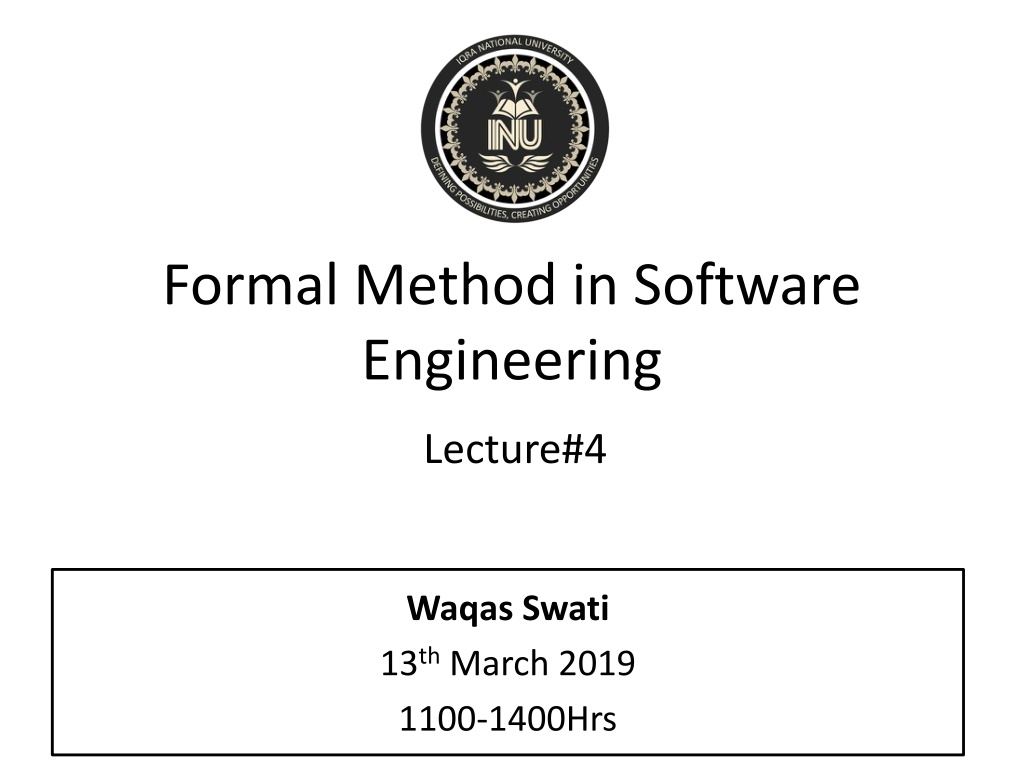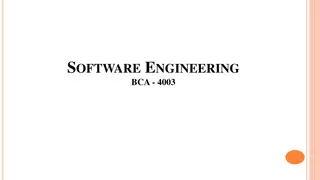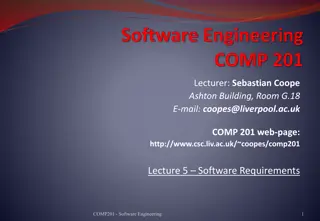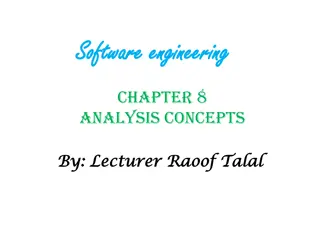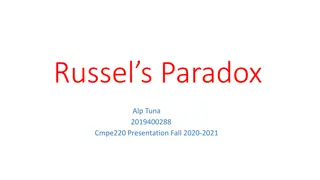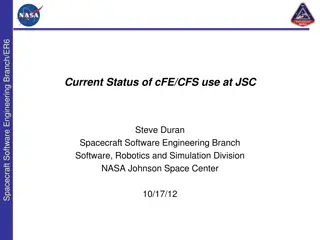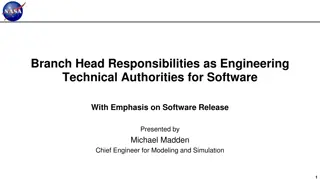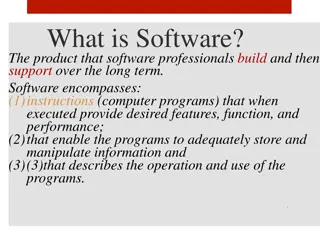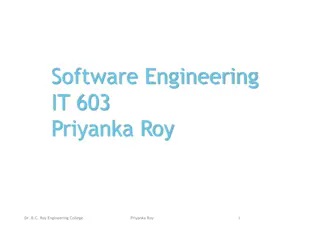Understanding Set Theory in Software Engineering Lecture
Sets, relations, and functions are foundational concepts in set theory, which is crucial in software engineering. This lecture covers topics such as types of sets, operations, relations, functions, set cardinality, subsets, and proper subsets. Explore the fundamentals of set theory with practical applications in computer science.
Download Presentation

Please find below an Image/Link to download the presentation.
The content on the website is provided AS IS for your information and personal use only. It may not be sold, licensed, or shared on other websites without obtaining consent from the author. Download presentation by click this link. If you encounter any issues during the download, it is possible that the publisher has removed the file from their server.
E N D
Presentation Transcript
Formal Method in Software Engineering Lecture#4 Waqas Swati 13th March 2019 1100-1400Hrs
Outline Chapter 4 Sets, Relations and Functions Set Theory Types, Operations, Computer representation of sets Relation Domain, Range, Application of relations Function Domain, Range, Co-Domain, Types of Function
Set Theory In mathematics, a set is a collection of distinct objects, considered as an object in its own right. Sets may be defined by using a predicate to constrain set membership. S = {n : : n 10 ^ n mod 2 = 0} ={2, 4, 6, 8, 10} Intersection of two sets Belongs to Does not belongs to Such that Null set or empty set Union of two sets : or |
Set Theory (Cont) Fundamental building block. Collection of well-defined objects. Same kind Distinct No repetition No Order Venn Diagram Set operations (Union, Intersection, Difference)
Set Theory (Cont) Empty Set or Null Set: A set which does not contain any element is called an empty set, or the null set or the void set and it is denoted by and is read as phi. In roster form, is denoted by {}. An empty set is a finite set, since the number of elements in an empty set is finite, i.e., 0. S={}
Set Theory (Cont) Set Cardinality The cardinality of a set is a measure of a set's size, meaning the number of elements in the set. For instance, the set has a cardinality of for the three elements that are in it. A = {1, 2, 3, 4}, A = I4I
Set Theory (Cont) Subset If A and B are two sets, and every element of set A is also an element of set B, then A is called a subset of B and we write it as A B or B A The symbol stands for is a subset of or is contained in Every set is a subset of itself, i.e., A A, B B. Empty set is a subset of every set. For example, Let A = {2, 4, 6} and B = {6, 4, 8, 2} Here A is a subset of B. What about B A??
Set Theory (Cont) Proper Set If A and B are two sets, then A is called the proper subset of B if A B but B A i.e., A B. The symbol is used to denote proper subset. Symbolically, we write A B. For example; A = {1, 2, 3, 4}, Here n(A) = 4 B = {1, 2, 3, 4, 5}, Here n(B) = 5 We observe that, all the elements of A are present in B but the element 5 of B is not present in A. So, we say that A is a proper subset of B. Symbolically, we write it as A B. No set is a proper subset of itself???
Set Theory (Cont) Power Set The collection of all subsets of set A is called the power set of A. It is denoted by P(A). In P(A), every element is a set. For example; If A = {p, q} then all the subsets of A will be: P(A) = { , {p}, {q}, {p, q}} Number of elements of P(A) = n[P(A)] = 4 In general, n[P(A)] = 2^m where m is the number of elements in set A.
Set Theory (Cont) Set Theoretical Operations (Union, Intersection and Set Difference Operation) Set Union . Union of two given sets is the smallest set which contains all the elements of both the sets. To find the union of two given sets A and B is a set which consists of all the elements of A and all the elements of B such that no element is repeated. Let set A = {2, 4, 5, 6}, set B = {4, 6, 7, 8} Taking every element of both the sets A and B, without repeating any element, we get a new set = {2, 4, 5, 6, 7, 8} Therefore, A B = {x : x A or x B}
Set Theory (Cont) Set Theoretical Operations (Union, Intersection and Set Difference Operation) Set Intersection . Intersection of two given sets is the largest set which contains all the elements that are common to both the sets. To find the intersection of two given sets A and B is a set which consists of all the elements which are common to both A and B. Let set A = {2, 3, 4, 5, 6} and set B = {3, 5, 7, 9} In this two sets, the elements 3 and 5 are common. The set containing these common elements i.e., A B = {3, 5} is the intersection of set A and B. A B = {x : x A and x B}
Set Theory (Cont) Set Theoretical Operations (Union, Intersection and Set Difference Operation) Set Difference \ or - If A and B are two sets, then their difference is given by A - B or B - A. If A = {2, 3, 4} and B = {4, 5, 6} A - B means elements of A which are not the elements of B. i.e., in the above example A - B = {2, 3} In general, B - A = {x : x B, and x A}
Set Theory (Cont) Computer Representation of Sets How set is stored and manipulated in computer? M={1,2,5,8} M={1,2,3,4,5,6,7,8,9,10} One-To-One Correspondence {1,1,0,0,1,0,0,1,0,0}
Relations The concept of relation in math refers to an association of two objects or two variables based some property possessed by them. Rachel is the daughter of Noah. This statement shows the relation between two persons. The relation (R) being is daughter of .
Relations (Cont) Let A and B denote the set animals and their young ones. If A and B are two non-empty sets, then the relation R from A to B is a subset of A x B, i.e., R A x B. If (a, b) R, then we write aRb and is read as 'a' related to 'b'. Thus, calf is related to cow. Kid is the young one of a goat. Thus, kid is related to goat. Clearly, A = {cat, dog, cow, goat} B = {kitten, puppy, calf, kid} The relation (R) being is young one of . Then the fact that, Kitten is the young one of a cat. Thus, kitten is related to cat. Puppy is the young one of a dog. Thus, puppy is related to dog. Calf is the young one of a cow. This fact can also be written as set R or ordered pairs. R = {(kitten, cat), (puppy, dog), (calf, cow), (kid, goat)} Clearly, R B A Thus, if A and B are two non-empty sets, then the relation R from A to B is a subset of A B, i.e., R A B. If (a, b) R, then we write a R b and is read as a is related to b.
Relations (Cont) Domain and Range of Relation The set of all first components of the ordered pairs belonging to R is called the domain of R. Thus, Dom(R) = {a A: (a, b) R for some b B}. The set of all second components of the ordered pairs belonging to R is called the range of R. Thus, range of R = {b B: (a, b) R for some a A}. Therefore, Domain (R) = {a : (a, b) R} and Range (R) s= {b : (a, b) R}
Relations (Cont) In the given ordered pair (4, 6); (8, 4); (4, 4); (9, 11); (6, 3); (3, 0); (2, 3) find the following relations. Also, find the domain and range. (a) Is two less than (b) Is less than (c) Is greater than (d) Is equal to
Relations (Cont) Application of Relations RDBMS Library Book Example Any other example??
Functions A function relates an input to an output. It is like a machine that has an output and an output. Where output is some-how related to input. "f(x) = ... " is the classic way of writing a function. And there are other ways, as you will see!
Functions (Contd) Difference between Function and Relation?? A function is a relation but not every relation is a function. For example, the relation in the diagram below is not a function since there are two arrows from the element a A.
Functions (Contd) Domain, Range and Co-Domain
Functions (Contd) Types of Function Total Function A function which is defined for all inputs of the right type, that is, for all of a domain. Square (x ) is a total function. Reciprocal (1/x) is not, since 0 is a real number, but has no reciprocal. Partial Function A function which is not defined for some inputs of the right type, that is, for some of a domain. For instance, division is a partial function since division by 0 is undefined (on the Reals).
Functions (Contd) A function is injective (a.k.a one-to-one ) if each element of the codomain is mapped to by at most one element of the domain. A function is surjective (a.k.a onto ) if each element of the codomain is mapped to by at least one element of the domain. (That is, the image and the codomain of the function are equal.) A function is bijective (a.k.a one-to-one & onto, one-to-one correspondence ) if each element of the codomain is mapped to by exactly one element of the domain.
Reading Assignment Go through chapter 4 of Concise Guide to Formal Methods https://staff.washington.edu/jon/z/glossary.ht ml https://www.math-only-math.com https://www.mathsisfun.com/sets/index.html 27
Assignment # 1 Application of Functions in functional programming. Computer typed single page is enough. Do check plagiarism and submit the similarity report (Similarity level=15%max). You may consult books or Internet. Use the front page provided on SIC. Make sure to write in your own words. Plagiarized submission will lead to zero marks. Deadline Next Class 28
